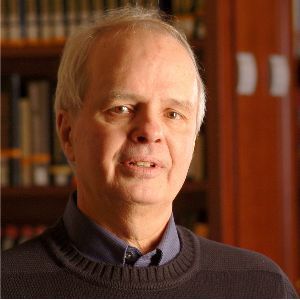
William F. Ruddiman is a climatologist and Professor Emeritus at the University of Virginia. His research interests center around preindustrial climate change and he is best known for studying human impacts on greenhouse gas concentrations preceding our burning of fossil fuels in the 1800s. His “early Anthropocene hypothesis” argues that anthropogenic climate change actually began 8,000 years ago with the emergence of widespread agricultural practices, which forestalled another glacial episode that we should have already entered. Ruddiman is the author of several books including Plows, Plagues and Petroleum: How Humans Took Control of Climate (2005), as well as over 125 scientific papers.
Nick Kolbas: I want to begin by discussing the concept of the Anthropocene in general. How would you describe the current debate about adding this epoch to the geologic timeline?
William Ruddiman: The Anthropocene is a time in which humans have come to play a major role in the climate system. Once, the climate system operated under natural conditions, but now humans are a new force. There is one group of climate scientists that think the Anthropocene should begin either around 1850 with the Industrial Revolution or in the mid 1900s with the Great Acceleration, the time in which measurable processes such as world population and greenhouse gas concentrations exploded. Then there is another group, of which I am a member, arguing that there is no single beginning date for the Anthropocene. Instead, human influence on the climate system began with the rise of agriculture, and our impact has increased ever since then.
When exactly did humans begin to have an impact on Earth’s climate?
If you really want to look at every human effect on the environment, you can go back 50,000 years ago when humans first came to Australia. Around the same time, most of the large marsupials became extinct. The most obvious explanation is that they were hunted down by humans. A similar event occurred around 12,000 years ago when the human population grew sufficiently on the Americas, and most of the large mammals on the continent went extinct. That is also widely attributed to hunting by humans. So, you could put the start of the Anthropocene at 50,000 or 12,000 years ago. Or, you could put it when humans came up with agriculture around 8,000 years ago, a time that aligns with anomalous changes in methane and carbon dioxide concentrations in the atmosphere. My point of view is that the beginning of the Anthropocene has no one date, but it’s an ongoing process.
Your research examines that last date, 8,000 years ago, as a time when humans first began changing Earth’s atmospheric composition. Could you summarize what evidence led you to form this ‘early Anthropocene hypothesis’?
There are two main pieces of evidence supporting my hypothesis: anomalous changes in atmospheric methane levels and carbon dioxide levels. Back in the 1980s and 90s, I was a member of a research group alongside John Kutzbach, Thompson Webb III, and Alayne Street-Perrott. We were studying the history of climate development over the last 20,000 years. One thing we discovered was that methane concentrations were low during the last glacial episode, reaching a peak 11,000 years ago. The source of this methane was thought to be wetlands in the tropics of the northern hemisphere, where you get swampy areas from a lot of rainfall. The water is fairly stagnant so it emits methane. Kutzbach came up with the idea that summer radiation was at a high around 11,000 years ago, so the rain was falling at high rates, wetlands were filling up and emitting a maximum amount of methane at that point. Alayne Street-Perrott hypothesized that as summer radiation levels began to decrease afterward, rainfall also decreased and lakes in the northern hemisphere began to dry out. So, methane levels began to decrease from 11,000 to 5,000 years ago.
Then, at 5,000 years ago, methane concentrations began to rise unexpectedly. That caught my eye. Most of the community looked for some natural reason for methane to rise like that. I thought something else must be intervening there. I did some archeology reading and found that in the Asian tropics around China, people began to farm irrigated rice. Even though the wetlands were drying out, these people were creating wetlands that were man-made. I proposed that this was a reason for the strange increase in methane 5,000 years ago. Archeological work in the past 15 years has indeed shown that rice patty creation in China and spreading across the rest of Southeastern Asia began 5,000 years ago and has increased markedly ever since. That’s the first part of my hypothesis, and one which I think is pretty well-proven.
The other part of my early Anthropocene hypothesis has to do with carbon dioxide. The carbon system is very complicated because carbon is basically everywhere, and all these carbon sinks interact with each other. It occurred to me that I could use the same technique I used with methane, that I could look at the carbon dioxide trend over the last 11,000 years and compare this interglaciation with previous interglaciations. Basically, I discovered that like methane, carbon dioxide had reached a peak about 11,000 years ago in this interglaciation and at the equivalent in previous interglaciations. Every time, CO2 concentrations began to decrease after this point. In this interglaciation, however, this decrease stopped and began to increase around 8,000 years ago. I figured out that humans, because they had developed agriculture, were cutting down forests to grow their crops on a pretty massive scale in China and Europe. There was my conclusion—people were cutting down forests and CO2 was getting into the atmosphere. That increase during this interglaciation is anomalous with respect to these previous natural interglaciations, so I concluded that the CO2 increase was anthropogenic.
Both of those increases, methane and CO2, had a modest effect on climate. In previous interglaciations, Earth’s climate had cooled as it naturally headed toward the next glacial episode. This time around, these anthropogenic greenhouse gas increases offset that cooling and climate stayed roughly stable. So, there’s a natural cooling counterbalanced by this anthropogenic greenhouse gas warming, which yielded a relatively stable and warm climate during the Holocene.
Keeping in mind that the human population was only about 5 million people 8,000 years ago, how is it that humanity could have had a significant effect on Earth’s climate?
That’s a good question, and it’s often been used as a critique of my hypothesis. The general picture of human populations is that there were only a few million people on Earth 10,000 years ago, and that number doubled every thousand years or so. But now there’s new evidence from archeological data that populations were indeed very small 10,000 years ago, but suddenly began a much more rapid increase than predicted by this traditional story. It’s actually not a model of steady doubling, but there’s what now looks like a surprisingly early explosion of population just when humans developed agriculture. Archaeological data suggests there was a population explosion around 7,000 years ago in China, and around 6,000 years ago in Britain. The obvious conclusion is that instead of being hunter-gatherers who had to move around for new food sources, humans were able to live in one place, build homes, and start growing crops that provided a steady food source allowing for a very rapid population increase.
According to your hypothesis, this early anthropogenic activity prevented the planet from tipping into another glacial episode. What might Earth look like if it weren’t for this human intervention?
I’ve worked with researchers—John Kutzbach, Steve Varvus, and Feng He—to model the climate that would have occurred if natural decreases in greenhouse gas had continued to the present day. What we found is that there’s a significant cooling, maybe 1 or 1.2°C on average globally, or in the Arctic regions it’s 3 or 4°C. One of the consequences of that is that northern North America up near Baffin Island begins to be covered with deeper and deeper snow year-round that signals an upcoming glaciation. That snow cover would thicken and turn into an ice sheet. I predicted that outcome twenty years ago in my first paper—I said that if these anthropogenic greenhouse gas increases hadn’t occurred 8,000 years ago, we would be taking a step toward the next ice age right now. It’s nothing like the kind of ice age you’d imagine with ice sheets down in New York and Chicago, but there would be glaciers up there, and those glaciers would be growing. Maybe 2,000 years ago is when this snow would have started accumulating, and humans prevented this from happening.
How does this early anthropogenic warming compare to present day warming after the Industrial Revolution?
Early anthropogenic warming is larger than you might think, even though a rapid greenhouse gas increase has only occurred in the last 150 years. I’ve used an old analogy of the tortoise and the hare to describe the two. The early anthropogenic warming is the tortoise, which moves really slowly, but it moves for 7,000 years so that the warming adds up to quite a considerable amount. The industrial-era warming is the hare, which is very rapid, but it has only been going on for the last 150 years. So, in fact, the two intervals have roughly equivalent warmings of 1 to 2°C. Also, it’s important to remember the climate system doesn’t respond quickly to any forcing, so the early anthropogenic increase in greenhouse gases was slow enough for the climate system to adjust along the way. But the industrial era increase has been very fast, and although it caused the system to warm up, we still have so much more global warming left to go, even if we stopped burning fossil fuels today.
What do you think are the implications of contextualizing our modern climate crisis in an ancient narrative of anthropogenic climate change?
Becoming aware of what humans did thousands of years ago doesn’t change what we know about the industrial era today. We still have data that shows temperatures over the last 150 years spiking rapidly. Early anthropogenic warming makes us more aware of where we come from, but it shouldn’t change our understanding of our current climate crisis. The early anthropogenic interval is like a baseline era on top of which the industrial era warming is stacked.
Also, it’s not as if technology began in 1850. Figuring out how to tend livestock or farm crops with plows—that’s all technology. That’s humans doing what humans do, just trying to find a way to produce more food with less labor. We had windmills, dams, waterwheels, and some pretty amazing technological developments well before the Industrial Revolution. Humans have always been innovative.
To come full circle, how do you see your early hypothesis playing into the existing debate about dating the Anthropocene?
There’s a group that mostly consists of geologists looking to establish a start date for the Anthropocene, and they’re on the verge of recommending the mid-1900s. The reason they’re choosing this date is that nuclear testing began around then, and the radioactive isotopes are spread widely across the world. That gives them a line in many geologic records at which to say the Anthropocene begins. If you try to do that anytime earlier, you’d have trouble finding a point at which Anthropocene indicators suddenly show up. So, they’re on the verge of recommending the Anthropocene as a new epoch beginning around 1950.
However, I’m part of a team that’s publishing a paper arguing the anthropocene should not be given a time designation, but that it should be called the Anthropocene Event. The way events are handled in geologic literature is that they don’t have a beginning or end, but they provide a narrative of what happened as the event developed. My team explained our reasoning for this argument in an article for Science magazine published in 2015. To boil it down, archeological data shows that about 2/3 to 3/4 of currently deforested areas on Earth had been cut before 1850. All the attention has been on the last 150 years, but that’s only 1/3 to 1/4 of humanity’s total deforestation effect. We said in the article: “Does it really make sense to define the start of a human-dominated era several millennia after most forests in arable regions had been cut for agriculture?”
Think of the Great Oxidation Event 2.5 billion years ago, a time when microorganisms changed the content of the atmosphere by producing oxygen. That change was gradual, and it’s known as an event. Now humans are another species that has gradually changed the atmosphere over the past 8,000 years, and we shouldn’t be so quick to name an entire epoch after ourselves. That’s why I argue for the Anthropocene Event. But this argument is going to continue on for a long time.
*This interview has been edited for length and clarity.




